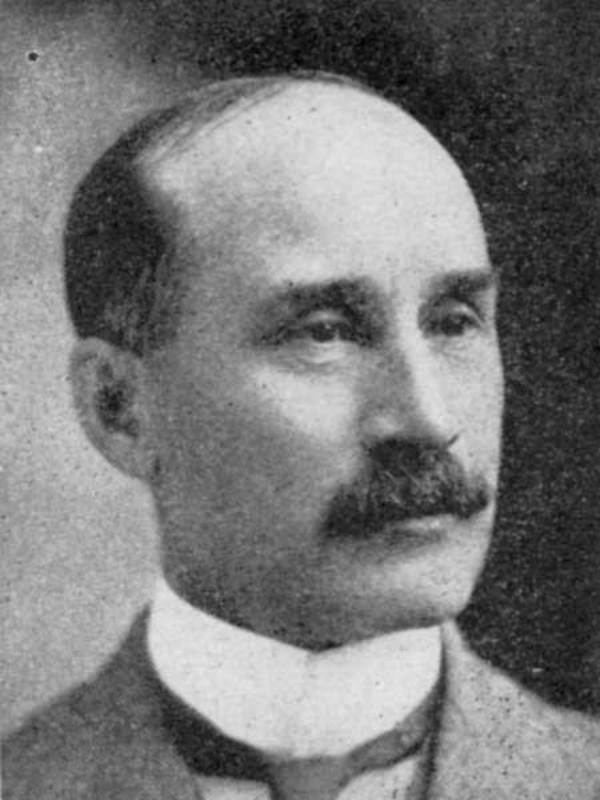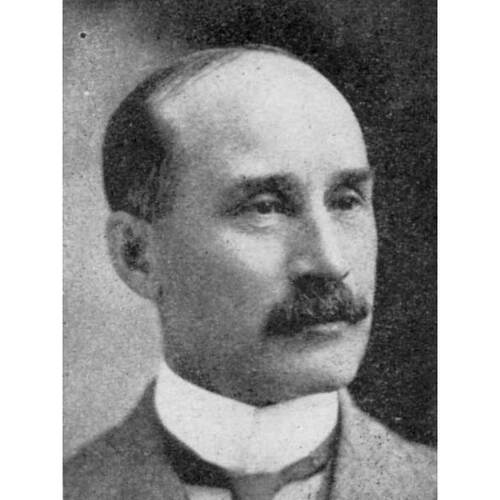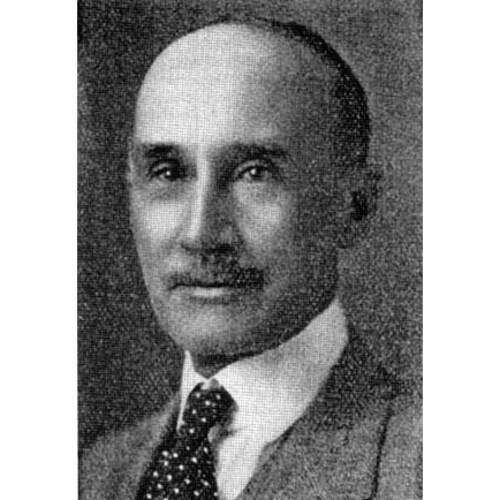
Source: Link
MACHRAY, JOHN ALEXANDER (named at birth John Alexander Macrae), lawyer, educational and church administrator, businessman, and criminal; b. 17 Feb. 1865 in Haddington, Scotland, son of William Forsyth Macrae and Jessie Panton; m. 22 June 1904 Emily Florence Drewry in Winnipeg, and they had five children; d. 5 Oct. 1933 in Rockwood, Man.
John Machray spent his childhood in Haddington, where his father was the governor of the local prison. In 1874 John and his brother, Robert, emigrated to Winnipeg to live with their uncle, Robert Machray*, who was the Anglican bishop of the diocese of Rupert’s Land and would be named metropolitan of the ecclesiastical province of the same name the following year. The boys flourished under his care. John’s brother became a clergyman and returned to Britain, where he would regularly contribute to the prestigious Fortnightly Review (London) and publish several books on European politics.
Educated at Winnipeg’s St John’s College (the Anglican college affiliated with the University of Manitoba), in 1884 Machray received his ba with first-class honours. He then went to England to attend Sidney Sussex College at the University of Cambridge, which awarded him an llb in 1887. Upon his return to Winnipeg he read law with the firm in which his uncle’s trusted friend Heber Archibald was a partner, as was Hector Mansfield Howell*. Machray was called to the Manitoba bar in 1890 and became a partner of the firm about 1897, along with Frederick J. Sharpe (Howell left the partnership around that time). In 1904, shortly after the death of his uncle, Machray married Emily Drewry, daughter of the wealthy brewer Edward Lancaster Drewry.
Archibald and Howell’s firm had managed the investments of the ecclesiastical province of Rupert’s Land, which at the beginning of the 20th century covered all the territory in Canada whose waters drain into Hudson Bay and the Arctic Ocean. Machray, Sharpe, and their new partner, Robert Maxwell Dennistoun, carried on with this work after Archibald left the firm around 1908. Machray was respected and trusted by churchmen because of his uncle’s position in the Church of England in Canada. Machray had been elected to the council of the University of Manitoba in 1906, and the next year his firm won the contract to manage all the institution’s investments. The compensation was $65 a month plus 5 per cent commission on all interest collected, an arrangement that would not change significantly over the next 25 years. In 1907 Machray became chancellor of the diocese of Rupert’s Land. Appointed university bursar in 1916, he was also a member of the board of governors, which he chaired in the 1920s and early 1930s. As well, he chaired the finance committee of his alma mater, St John’s College, in the 1920s and became its bursar in 1924.
One of the university’s main sources of funding was a federal land grant of 50,000 acres, which was administered by the land board under the chairmanship of Robert Machray’s successor as metropolitan, Samuel Pritchard Matheson*. This group selected lands and sold them, generating by the mid 1920s a total of roughly $1,087,000. In addition, the university received bequests and gifts from bodies such as the Rockefeller Foundation and individuals such as Alexander Kennedy Isbister*. These moneys and funds from the diocese and St John’s College, a total of close to $2,000,000, were all managed by Machray’s firm. The methods used by the firm’s accountant, Robert Hance Shanks, were highly questionable. All the trust funds, along with the savings of the partners and some small investors, were held in one account. The books, however, showed multiple accounts and were not kept up to date.
Machray had begun using the substantial amount of money under his management to invest in real estate and building projects around 1907. Over the next five years, a period of booming property prices in Winnipeg, he entered into partnerships with many other members of the city’s elite, including politician Robert Rogers and businessman George Frederick Galt*, to make these investments. One example was the purchase of a large tract west of the city, marketed as the future site of an exclusive suburb, Silver Heights.
In 1912, at the climax of the real-estate boom, Machray and Sharpe were wealthy men. By the end of that year, however, prices had collapsed. While some of the investments maintained their value, many of the ventures, such as the Silver Heights development, were suddenly worth much less than Machray had paid for them. In 1913 he was very likely on the verge of bankruptcy but chose to carry on in the hope that conditions would improve. He paid the taxes and other expenses on many properties by taking out mortgages or using trust money under his management. But the situation did not improve and his actions had resulted, by 1918, in a $500,000 shortfall in the firm’s trust account. The other partners in the firm, which by then also included Charles Holland Locke, Benjamin Cronyn Parker, and Alan Crawley, reacted badly when Shanks informed them of the situation, but Machray reassured them by agreeing to divide the law side from the investment side of the business to distance them from any problems.
Machray adopted a variety of methods to hide his financial difficulties. He used the prestige of his position in Winnipeg society and the confidence of his clients to escape the scrutiny that others might have experienced. As both chair of the board of governors and bursar of the university, he had many opportunities to conceal irregularities. He postponed the provincial comptroller-general’s mandatory annual audits by claiming that Shanks was ill and unable to bring the books up to date. Three audits were conducted between 1919 and 1930, but each time Machray evaded exposure by transferring money from account to account in the books to make it seem as if all the funds were in place. The bulk of the money in his care was moved from land and mortgage investments to bonds, which were easier to liquidate. He continued to pay university grants, land taxes, and interest charges from capital rather than from non-existent investment income. By the late 1920s there was little improvement in the economy and Machray was running out of money. He adopted more desperate measures, such as speculating in wheat futures and oil stocks, all without success.
After a partial audit in 1931, Machray was repeatedly asked to produce securities to cover a shortage of over $600,000. For almost a year he delayed, still hoping to avoid disaster. In August 1932 he was finally arrested for theft. The law firm declared bankruptcy a few weeks later. At his brief trial Machray, who was suffering from stomach cancer, pleaded guilty and was sentenced to seven years in Stony Mountain Penitentiary. Shortly afterwards, Premier John Bracken* established a royal commission to inquire into what had become known as the Machray scandal. In January 1933 it found that Shanks (who had since died) and Machray were primarily responsible, and that Machray had taken about $300,000 for his personal use. Sharpe was found guilty of negligence and was financially ruined. More broadly, the commission denounced the system that had allowed the embezzlement to happen. Nine months later, Machray succumbed to his disease in prison.
The collapse of Machray’s investment business was a heavy blow for the Church of England in western Canada, St John’s College, the University of Manitoba, and many small investors, among them his former partner Heber Archibald. The losses were estimated at about $1.9 million, of which only $40,000 was recovered through Machray’s life-insurance policy. It would be many years before the institutions involved were able to replace the funds [see Clarendon Lamb Worrell]. In the civic sphere, Machray’s misappropriations shook people’s confidence in the ability of Winnipeg’s old elite to run its affairs.
John Alexander Machray is the author of “Reminiscences of the college era in university development,” Univ. of Manitoba Quarterly (Winnipeg), 2 (1927–28), no.1: 17–22.
Ancestry.com, “Scotland, select births and baptisms, 1564–1950”: www.ancestry.ca (consulted 26 Nov. 2018). Man., Dept. of Justice, Vital Statistics Agency (Winnipeg), no.1933-039400. Univ. of Man. Libraries, Dept. of Arch. and Special Coll. (Winnipeg), Ua 10, box 28b, Report 1933 (Report of the royal commission on impairment of University of Manitoba trust funds). Jim Blanchard, “The Machray scandal,” Manitoba Hist. (Winnipeg), no.33 (spring 1997): 27–37. M. J. Hunter, “A history of the financial administration of the University of Manitoba, 1877–1932” (ma thesis, Univ. of Man., 1985). W. L. Morton, One university: a history of the University of Manitoba, 1877–1952 ([Toronto], 1957).
Cite This Article
Jim Blanchard, “MACHRAY, JOHN ALEXANDER (John Alexander Macrae),” in Dictionary of Canadian Biography, vol. 16, University of Toronto/Université Laval, 2003–, accessed December 18, 2025, https://www.biographi.ca/en/bio/machray_john_alexander_16E.html.
The citation above shows the format for footnotes and endnotes according to the Chicago manual of style (16th edition). Information to be used in other citation formats:
| Permalink: | https://www.biographi.ca/en/bio/machray_john_alexander_16E.html |
| Author of Article: | Jim Blanchard |
| Title of Article: | MACHRAY, JOHN ALEXANDER (John Alexander Macrae) |
| Publication Name: | Dictionary of Canadian Biography, vol. 16 |
| Publisher: | University of Toronto/Université Laval |
| Year of publication: | 2022 |
| Year of revision: | 2022 |
| Access Date: | December 18, 2025 |




